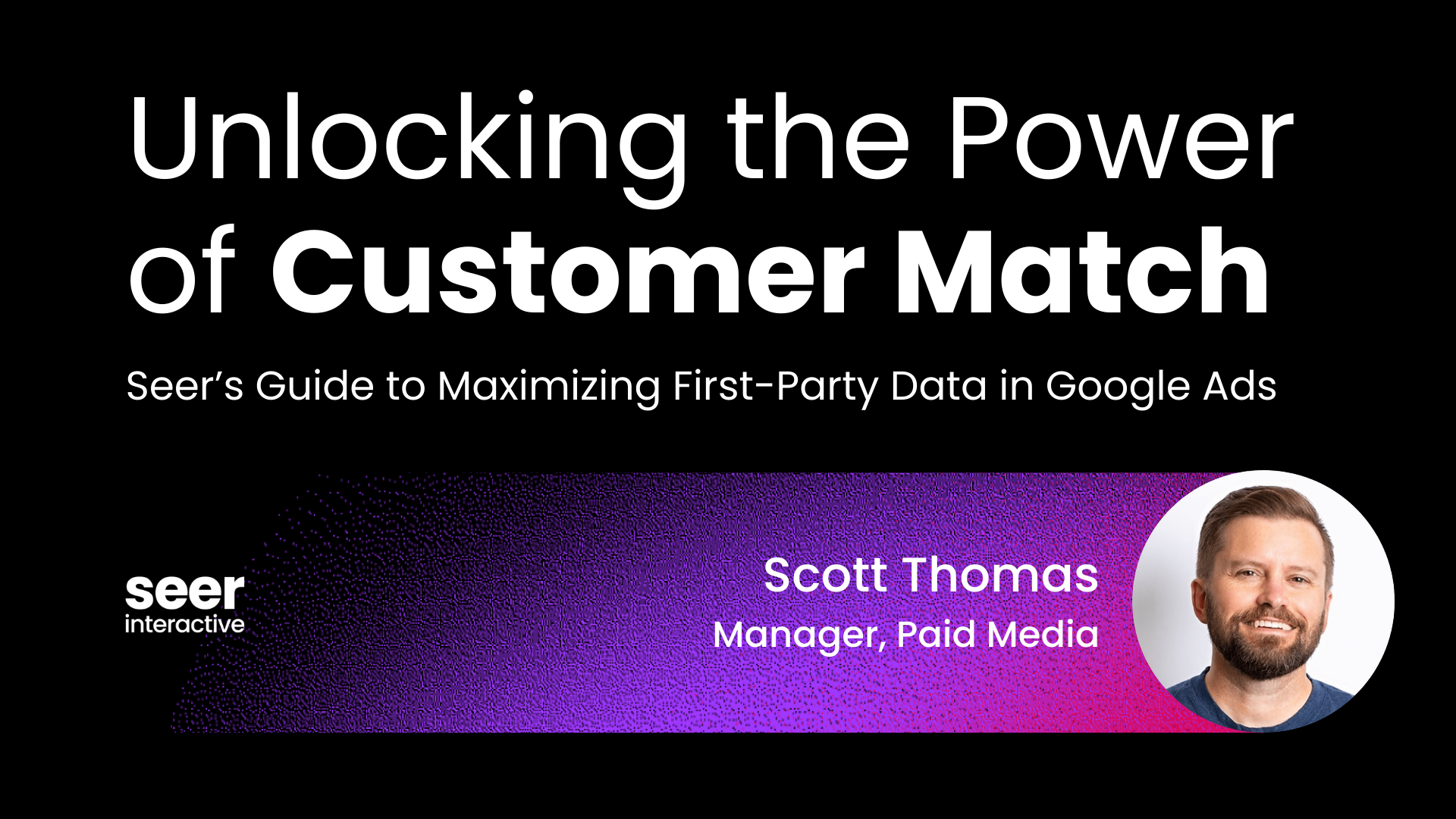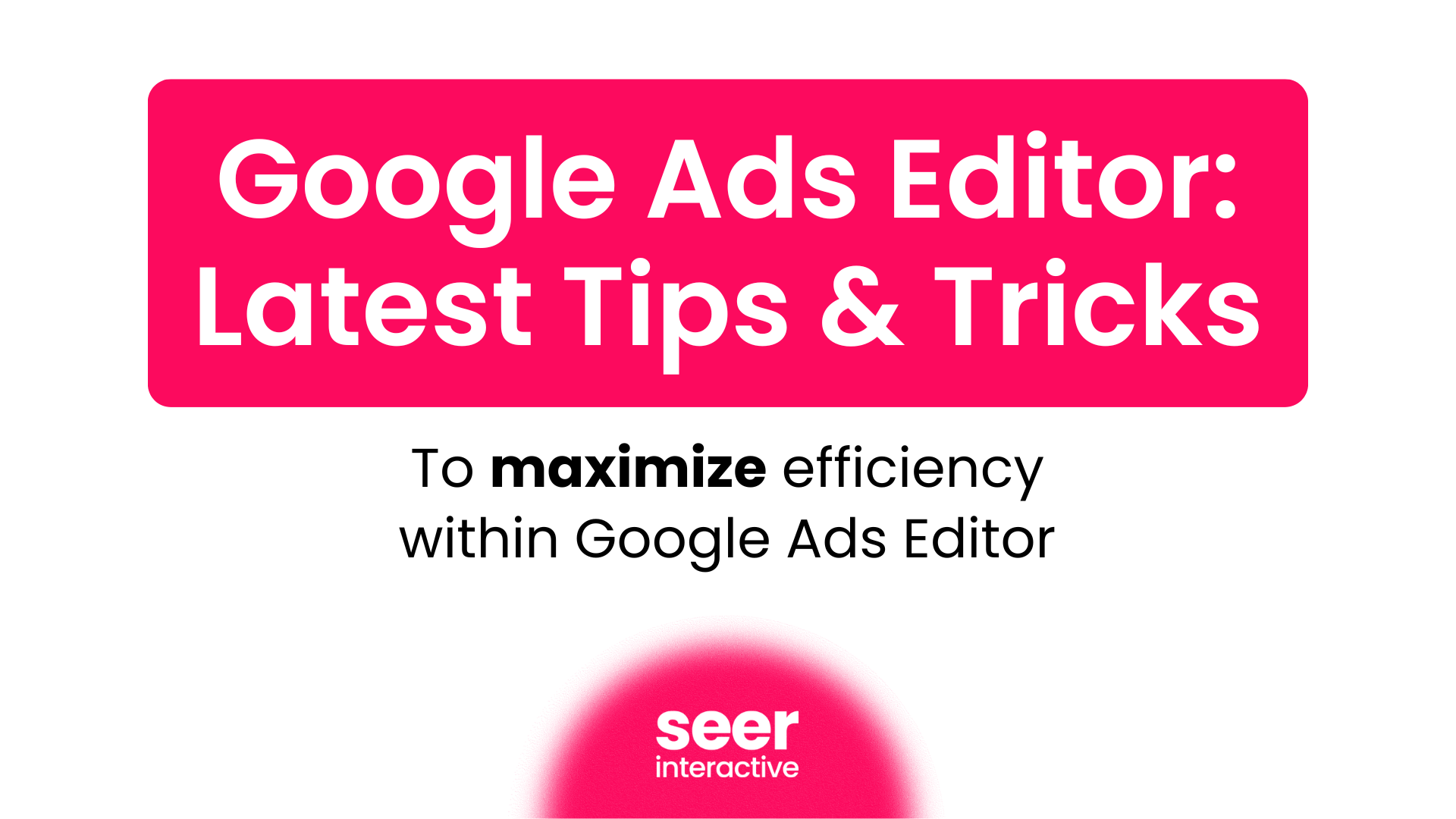 Marisa
Marisa Rosso
 Chris
Chris Evans
 David
David Lacamera
 Bethany
Bethany Driskill
 Jess
JessHenderson
 Hayley
Hayley Cornelius
 Rose
Rose Neukam
 Brittany
BrittanySager
 Rene
ReneRadloff
Remember when social media first burst onto the scene and everyone thought it was just a fad? Well, Performance Max is the new social media of Google Ads—only this time, it's got a PhD in automation and a black belt in conversions. Think of it as the Swiss Army knife of digital marketing: it slices through the clutter, dices your target audience, and serves up ads on a silver platter across all of Google's platforms. Whether you're an eCommerce guru or a local business maven, Performance Max is here to revolutionize your advertising game, one automated campaign at a time.
In this guide, you'll hear from Seer Experts who are using Performance Max in their day-to-day work. They’ll share insights on the varied applications of PMAX across industries, practical optimization strategies, and tips to ensure your campaigns are set up for maximum success. Get ready to dive deep into the nuances of this powerful tool and unlock its full potential!
1. What is Performance Max?
Performance Max campaigns in Google Ads are fully automated, goal-based campaigns that optimize ad placements across all of Google's channels, including Search, Display, YouTube, and more. They use machine learning to optimize bids, creative assets, and targeting to help advertisers achieve their specific conversion goals. These campaigns are designed to increase reach and drive more conversions by leveraging Google's wide network and data insights.
When talking about Performance Max, we typically like to make a distinction between which type of PMAX campaign we’re talking about. So far, these are the most relevant distinctions:
- PMAX for Ecommerce (includes a product feed)
- PMAX for Lead Gen (optimizing towards a web or CRM based conversion signals)
- PMAX for Healthcare (or other sensitive categories where conversion or CRM data is limited)
- PMAX for Local (optimizing towards foot traffic via store visits)
Is Performance Max Worth It?
In a nutshell, Performance Max (PMAX) can be a game-changer for businesses looking to expand their reach and optimize their ad spend across Google's ecosystem.
By leveraging Google's AI to automate and optimize ad placements, PMAX can efficiently target a wide range of audiences, making it a versatile tool for various industries and objectives.
Performance Max In Action
PMAX for E-commerce
For e-commerce, PMAX is a powerhouse. It excels in automating product feed ads, ensuring your products are showcased across multiple channels, including Google Shopping, YouTube, and the Display Network. The campaign’s ability to leverage rich data from your product feeds and customer behavior can significantly boost sales and ROI. With PMAX, you can tap into audience segments that may not have been reachable through traditional search campaigns alone, providing a comprehensive approach to online retail.
REAL-WORLD EXAMPLE: For one eCommerce client, transitioning from Smart Shopping to Performance Max resulted in a significant increase in overall performance. We saw ROAS increase by 15%, CPCs decreased by 3% and revenue increase by 47%.
PMAX for Lead Generation
In the realm of lead generation, PMAX is a robust option. Its broad reach and data-driven approach allow for precise targeting, capturing leads from various sources that may not be as accessible through other campaign types. By integrating CRM data, businesses can track offline conversions and optimize their campaigns for high-quality leads. This makes PMAX particularly effective for industries where traditional targeting options are limited or highly regulated.
REAL-WORLD EXAMPLE: For a lead generation client, Performance Max drove a 55% lower CPL than search campaigns for Qualified Leads with CRM integration.
On another client without CRM integration we continue to see cost savings with performance max having a -60% cheaper CPC and -57% lower CPA than search campaigns.
PMAX for Healthcare
Hayley Cornelius uses PMax for lead gen across a few healthcare industry clients and it works very well! With targeting options being so limited in healthcare it’s been a great workaround to find the right audience. In terms of efficiency we’ve occasionally been able to outperform Search!
REAL-WORLD EXAMPLE: For a healthcare client, Performance Max proved effective in reducing CPA by 37% and increasing conversion quality.
PMAX for Local
Chris Evans states PMAX is the only campaign type that allows targeting "Get Directions" as a conversion goal, which is important for local businesses that aren't hitting the performance thresholds needed to generate "Store Visits". This is a pretty niche need, but I have run into it. Happens most in rural areas. It's really great for local advertising as well as long as they have a revenue model that is vetted associated with it.
Conclusion
Performance Max offers unique advantages across different sectors. For healthcare, it's a valuable workaround for targeting constraints, while for local businesses, it's the go-to for driving foot traffic with the "Get Directions" conversion goal. In e-commerce and lead gen, its comprehensive approach and data integration capabilities make it a highly efficient tool. So, is Performance Max worth it?

Absolutely—if you're looking to maximize your reach and fine-tune your ad strategy across Google's expansive network, PMAX should be a key component of your digital marketing arsenal.
But… What About Search Term Data?
Ah, the elusive search term data—it's the white whale of Performance Max campaigns. Advertisers have been grumbling about the lack of transparency and dwindling access to this precious intel.

With reporting to search queries decreasing over time, it’s important to ensure you find keyword themes that behave differently and make sure they are segmented so you are driving the best possible user experience for queries most likely to match to those keywords. Sometimes, this will mean having very similar keywords in different ad groups due to nuanced differences in intent. Also, whenever possible, use efficiency levers like tCPA and tROAS to train the algorithm on what you need to see in performance and keep irrelevant queries in check. As search term reporting continues to decrease, it will be critical to capture and act on the data you have today.
How should optimization levers change from traditional search to performance max?
Switching from traditional search campaigns to Performance Max? Don't worry; the fundamentals stay the same, but with a twist. Instead of relying heavily on keywords, you'll lean into three key pillars:
- Bidding & Automation: Let Google's AI handle the heavy lifting.
- Targeting Criteria: Use audience signals instead of keywords.
- Ads & Creatives: Craft diverse asset groups to engage users across all of Google's channels.
Think of it as leveling up your strategy while keeping the basics intact!
Here’s how they look a little different for Search vs. PMAX:

PRO TIP: Maximize Your Creative Arsenal

Bonus Tip: Remember to use diverse asset types to appeal to different stages of the customer journey. Incorporate assets that not only showcase your products or services but also address common questions, pain points, and benefits. This ensures a well-rounded and persuasive campaign that resonates with various audience segments.

PRO TIP: Script Your Way To Success

PRO TIP: Elevate Your Product Feed
When it comes to Performance Max and e-commerce, your product feed is like your digital storefront—make it sparkle! Keep those product titles snazzy and accurate, show off with high-quality images, and don't forget the essentials like price and availability. Update regularly to keep things fresh and relevant, because no one wants to click on a "sold out" item. This not only makes Google love you but also ensures your ads reach the right shoppers at the right time. Your feed's gotta be on fleek!
PRO TIP: Master Budget & Bids
Nailing your budget and bids in Performance Max is like hitting the jackpot. Set your daily budget with care—enough to get results, but not so much that you're throwing cash at every click. Let Google's smart bidding do the heavy lifting with strategies like Target CPA or Target ROAS, optimizing for those sweet conversions. Keep an eye on your spending and tweak as needed; a little adjustment can go a long way in maximizing your bang for the buck. It's all about finding that perfect balance!

How should I set-up my PMAX campaigns for success?
When structuring your Performance Max campaigns, think of it like organizing a killer playlist—everything needs to be in the right place for maximum impact. Start with well-defined asset groups, tailored to specific audiences or product lines. This helps Google serve the most relevant ads to the right people. Keep your campaign settings streamlined and consistent, and don’t go overboard with too many asset groups or conversion actions; it can confuse the algorithm. Use audience signals wisely to guide your targeting and ensure you’re hitting the right notes. The goal? Harmonize your efforts for a smooth, efficient, and effective campaign.
PRO TIP: Know When To Split Campaigns & Asset Groups
Deciding between multiple campaigns or asset groups in Performance Max? Think of it like choosing between a mixtape and an album. Use multiple campaigns when you have distinct business objectives, budgets, or target audiences that need separate tracking and optimization. For example, you might separate campaigns for different product categories or regions.
On the other hand, multiple asset groups within a single campaign are perfect for testing creative variations or targeting different audience segments under the same goal. This helps Google’s AI find the best-performing combinations without muddying your overall strategy.
Remember, the key is to keep it clean and purposeful—avoid unnecessary complexity and make sure each element serves a clear, strategic function!
PRO TIP: Migration Magic vs. Starting Fresh

PRO TIP: Optimize Audience Signals
With Performance Max, audience signals are like your campaign's secret sauce—get them right, and you're cooking with gas! Start with Customer Match to target your existing customers and people who look like them. Then, spice things up with custom segments based on your audience's interests and behaviors. Don't forget to add remarketing lists to re-engage those who’ve interacted with your brand but haven't converted yet. And, of course, use similar segments to find new users similar to your high-value customers. Mix and match these signals to create a robust targeting strategy that’s as unique as your brand!
Don’t forget about brand exclusions. This feature is like the bouncer at a VIP club—it keeps the riff-raff out. Use brand exclusions to avoid showing your ads to users interested in certain brands, ensuring your message reaches the most relevant audience. It’s particularly handy if you want to avoid competitors' customers or irrelevant brand affiliations. Think of it as adding an extra layer of precision to your targeting strategy, keeping your campaigns sharp and focused!
PRO TIP: Test A Page Feed for Lead Gen
.png?width=1080&height=1080&name=PDM%20Blog%20Rose%20Neukam%20(2).png)
PRO TIP: Nail Your Conversion Signals
When setting up conversion signals in Performance Max, make sure you're not just throwing everything at the wall to see what sticks. Focus on the actions that matter most to your business, like purchases or key lead gen activities. For bonus points, include micro-conversions—those little nudges that show users are interested, like watching a video or clicking on a product. And if you're in the lead gen game, feed in CRM data to track offline wins. The more precise your signals, the more dialed-in your campaign performance will be!
.png?width=1080&height=1080&name=PDM%20Blog%20Rene%20Radloff%20(2).png)
PRO TIP: Test the Waters with Uplift Tests

Setting Up Uplift Tests: Ready to see if Performance Max can give your search campaigns a serious boost? Start by setting up an uplift test in Google Ads. Create two groups: one gets your regular search ads, while the other enjoys the mix of search and PMAX. Make sure to run this experiment long enough to gather juicy data—think weeks, not days. Learn more here.
Interpreting the Results: As the test runs, keep your eyes peeled for key metrics like conversion rates, CPA, and overall conversion volume. Compare these between your control group (search-only) and your experimental group (search + PMAX). A solid increase in conversions or a drop in CPA? That's your green light that PMAX is pulling its weight.
Implementing Changes Based on Findings: Got positive results? Time to roll PMAX into your main strategy. Start with a gradual budget increase to avoid rocking the boat. Also, fine-tune your settings—audience signals, creative assets, the works—based on what kicked butt in the test. If the uplift was more meh than wow, don't sweat it. Go back to the drawing board, tweak your setup, and give it another go.
Nail these steps, and you'll be leveraging PMAX like a pro, optimizing your campaigns for maximum impact and minimum hassle!
PRO TIP: Keep Your Finger on the PMAX Pulse

When should I leverage Performance Max vs. Demand Gen?

For more details on Google Performance Max vs. Demand Gen, visit the full blog here.
Recap of Common Pitfalls and How to Dodge Them Like a Pro
- Over Relying on Auto-Pilot: PMAX's automation is awesome, but don't treat it like a self-driving car—you're still in the driver's seat! Letting Google handle everything might sound tempting, but it can lead to missed opportunities.
- Hack: Keep a close eye on your campaigns, tweaking settings, and optimizing creative assets regularly. Use your human intuition to complement the machine's insights.
- Conversion Tracking Fumbles: Not setting up conversion tracking properly is like trying to win a game without keeping score. It can throw off your whole strategy.
- Pro Move: Double-check that all your conversions, including those tiny but mighty micro-conversions, are being tracked correctly. And don't forget those offline conversions!
- Audience Signal Snooze: If you're not segmenting your audience, you're basically casting a wide net and hoping for the best.
- Pro Tip: Get specific with your audience signals. Use Customer Match, custom segments, and remarketing lists to make sure your ads are hitting the right eyeballs. Oh, and brand exclusions? They're your new best friend for keeping out the riff-raff.
- Budget Blunders: Blowing your budget or pinching pennies too tightly can both spell disaster.
- Pro Tip: Set clear budget caps and monitor them like a hawk. Use automated bidding strategies like Target CPA or Target ROAS, but don't be afraid to adjust based on real-time data.
- Creative Fatigue: Reusing the same ads can lead to audience burnout faster than you can say "skip ad."
- Pro Tip: Keep your creative assets fresh and varied. Regularly swap out old creatives and experiment with new formats and messages to keep your audience engaged.
Avoid these pitfalls, and you'll be cruising down the road to PMAX success, leaving your competition in the dust!
Conclusion
Performance Max (PMAX) has proven itself as a versatile and powerful tool in the digital marketing arsenal. Whether you're in e-commerce, healthcare, lead generation, or local business, PMAX offers unique advantages that can elevate your campaigns. Its AI-driven approach optimizes across Google's entire network, automating placements and leveraging rich data insights. From showcasing products across multiple channels to precisely targeting potential leads, PMAX adapts to various business needs and goals.
While the lack of detailed search term data remains a challenge, savvy marketers can still maximize their campaigns by focusing on strong conversion signals, leveraging audience signals, and making strategic use of uplift tests. As PMAX continues to evolve, staying ahead with the right strategies and optimizations will be key to making the most of this robust advertising solution.


